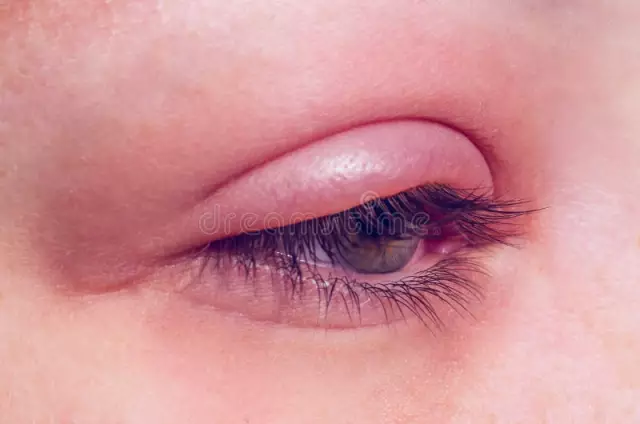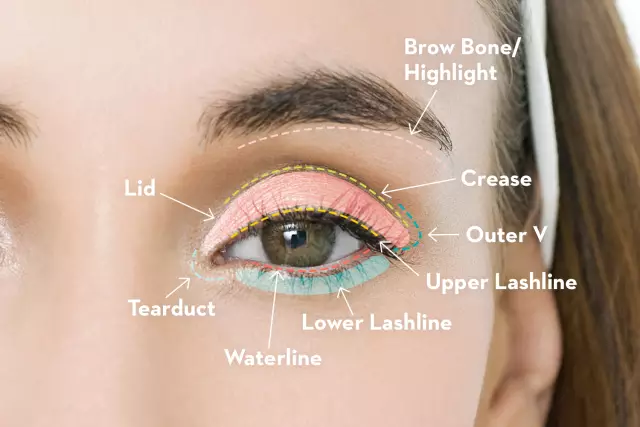- Author Rachel Wainwright [email protected].
- Public 2023-12-15 07:39.
- Last modified 2025-11-02 20:14.
Nevanak
Nevanak: instructions for use and reviews
- 1. Release form and composition
- 2. Pharmacological properties
- 3. Indications for use
- 4. Contraindications
- 5. Method of application and dosage
- 6. Side effects
- 7. Overdose
- 8. Special instructions
- 9. Application during pregnancy and lactation
- 10. Use in childhood
- 11. Drug interactions
- 12. Analogs
- 13. Terms and conditions of storage
- 14. Terms of dispensing from pharmacies
- 15. Reviews
- 16. Price in pharmacies
Latin name: Nevanac
ATX code: S01BC10
Active ingredient: nepafenac
Producer: Alcon-Couvreur NVSA (Belgium)
Description and photo update: 2018-23-10
Prices in pharmacies: from 470 rubles.
Buy

Nevanak is an NSAID (non-steroidal anti-inflammatory drug) for topical use in ophthalmic practice.
Release form and composition
Nevanak is available in the form of eye drops: a suspension of a uniform consistency from light yellow to light orange (5 ml in dropper bottles, 1 bottle in a cardboard box).
1 ml of the drug contains:
- active substance: nepafenac - 1 mg;
- excipients: carbomer (974R), benzalkonium chloride (50% solution), disodium edetate, tyloxapol, sodium chloride, mannitol, hydrochloric acid and / or sodium hydroxide, purified water.
Pharmacological properties
Pharmacodynamics
Nepafenac is a precursor to the active form of NSAIDs with analgesic and anti-inflammatory effects. When applied topically as part of eye drops, the substance penetrates the cornea, where, with the participation of hydrolases, it is converted into an active form - amfenac, which inhibits the action of cyclooxygenase (prostaglandin H-synthase), which is necessary for the production of prostaglandins.
Topical application of nepafenac can reduce pain and swelling of the ocular tissues without significantly affecting intraocular pressure.
Pharmacokinetics
The absorption of nepafenac through the cornea is rapid. In the case of three daily instillation of drops of Nevanak in both eyes in the blood plasma, after 2 hours, a low measured concentration of nepafenac was recorded, after 3 hours - of amphenac. The maximum value of the average concentration of nepafenac in plasma (Cmax) after topical application is 0.31 ± 0.104 ng / ml, amphenac is 0.422 ± 0.121 ng / ml.
In the aqueous humor of the eye chambers, the maximum concentration of nepafenac is reached on average after 60 minutes.
Amphenac has a high affinity for serum albumin. The in vitro binding to human serum, human albumin and rat albumin was 99.1%, 95.4% and 98.4%, respectively.
In a study in rats, it was shown that radioactively labeled substances associated with nepafenac after single or multiple oral administration of 14 C-nepafenac are widely distributed in the body.
With local application of nepafenac under the influence of intraocular hydrolases, a rapid hydrolysis of this substance occurs to amfenac.
Amphenac metabolism occurs through the hydroxylation of the aromatic ring, resulting in the formation of conjugates with glucuronic acid. The data of radiochromatographic analysis carried out before and after hydrolysis showed that all metabolites (except for amphenac) are represented by conjugates with glucuronic acid. Amphenac is the main metabolite of nepafenac, which accounts for approximately 13% of the total radioactivity detected in plasma. The second most common metabolite (5-hydroxynepafenac) accounts for about 9% of the total radioactivity detected in plasma.
Nepafenac is excreted mainly by the kidneys: after oral administration of the active substance, approximately 85% of the 14 C-nepafenac radioactive label is found in urine, and about 6% in feces. At the same time, the concentration of amphenac and nepafenac in urine is not quantifiable.
Indications for use
According to the instructions, Nevanak is recommended to be used for the prevention and treatment of postoperative pain and inflammatory processes during cataract surgery.
Contraindications
- acute rhinitis, urticaria, bronchial asthma caused by the use of acetylsalicylic acid and other NSAIDs;
- children and adolescents up to 18 years old;
- hypersensitivity to the components of the drug.
Instructions for use of Nevanak: method and dosage
Eye drops Nevanak are applied topically by instilling a suspension into the conjunctival sac. Shake the bottle well before using the drug.
Recommended dosage: 1 drop 3 times a day. Treatment begins 1 day before cataract surgery and continues for the first 2 weeks in the postoperative period (including the day of surgery). An additional dose of Nevanak should be instilled 0.5-2 hours before the operation.
Side effects
- local reactions: 1-10% of cases - punctate keratitis, itching and pain in the eye, dry conjunctiva, blurred vision, crusting at the edge of the eyelid, foreign body sensation; 0.1-1% of cases - eye discharge, corneal deposits, keratitis, iritis, choroidal effusion, photophobia, allergic conjunctivitis, eye irritation, eye discomfort, eyelid dysfunction, conjunctival hyperemia, increased lacrimation;
- systemic side effects: 1-10% of cases - headache; 1-4% of cases - vomiting, nausea, increased blood pressure, sinusitis; 0.1-1% of cases - skin elasticity, hypersensitivity, dry mouth;
- post-marketing observations: disease / defect of the corneal epithelium, ulcerative keratitis, corneal damage, the appearance of an inflammatory infiltrate in the anterior chamber of the eye, decreased visual acuity, corneal opacity, impaired corneal healing, the appearance of a scar on it.
Patients with symptoms of corneal injury should immediately stop using Nevanak and ensure a thorough examination of the cornea.
The experience of local use of NSAIDs indicates an increased risk of side effects from the cornea and, as a consequence, the threat of vision loss in patients with the following conditions: complications after ophthalmic surgery, corneal epithelial defects, corneal denervation, superficial eye diseases (for example, keratoconjunctivitis dry also called dry eye syndrome), diabetes mellitus, rheumatoid arthritis, repeated surgical interventions performed within a short period of time.
Overdose
There is no information on drug overdose.
If an excessive amount of the drug gets into the eye, rinse it with warm water.
special instructions
When using Nevanak, patients are advised to avoid exposure to intense sunlight.
Topical application of NSAIDs can cause the development of keratitis. With increased susceptibility, patients after long-term topical use of NSAIDs in the cornea of the eye may develop thinning, rupture of epithelial cells, ulceration, perforation or erosion. These side effects can lead to loss of vision. In case of rupture of corneal epithelial cells, you should immediately stop using Nevanak and consult a doctor to ensure monitoring of its condition.
With topical use of NSAIDs or glucocorticosteroids, as well as the combined use of these drugs, the healing process may be delayed or slowed down.
In the case of topical use of NSAIDs in patients with complications after ophthalmic surgery, corneal epithelial defects, corneal denervation, superficial eye diseases (for example, with dry eye syndrome), diabetes mellitus, rheumatoid arthritis, repeated surgeries carried out over a short period of time, the risk increases side effects from the cornea, which can lead to loss of vision. For the treatment of such patients, topical administration of NSAIDs should be used with caution. Long-term use can increase the risk and severity of corneal side effects.
Topical use of NSAIDs in combination with eye surgery can cause intense bleeding in the tissues of the eye (including hyphema). Nevanak should be used with caution to treat patients with a history of bleeding tendencies, or when used concomitantly with drugs that increase blood clotting time.
There is no information on the joint use of prostaglandin and Nevanak analogues, however, given their mechanism of action, it is not recommended to use these drugs simultaneously.
Nevanak contains benzalkonium chloride, a preservative that can cause eye irritation and discoloration of soft contact lenses, so the use of the latter is not recommended for drug treatment. In the postoperative period after cataract surgery, wearing contact lenses is also not recommended.
Studies have shown that benzalkonium chloride can cause toxic ulcerative and / or punctate keratitis, therefore, with prolonged or frequent use of the drug, careful medical monitoring of the patient's condition is required.
Topical application of NSAIDs can interfere with the timely diagnosis of symptoms of acute ocular infection, since they do not have any antimicrobial properties. With the development of an eye infection, the simultaneous local use of NSAIDs and antibacterial agents must be carried out with caution.
When using nepafenac, there is a risk of cross-sensitivity to phenylacetic acid derivatives, acetylsalicylic acid and other NSAIDs.
The bottle must be closed after each use. To avoid contamination of the contents and of the bottle itself, do not touch the dropper tip to any surfaces.
Influence on the ability to drive vehicles and complex mechanisms
As a result of the use of Nevanaka, the clarity of visual perception may be temporarily reduced. Until its recovery, you should abandon driving and other activities that require increased reaction and attention.
Application during pregnancy and lactation
Nevanak is not recommended for use during pregnancy and lactation. If necessary, use during lactation should interrupt breastfeeding during treatment.
Animal studies have shown the reproductive toxicity of Nepafenac. Reception of toxic doses (more than 10 mg / kg) in rats led to dystocia, an increase in the number of spontaneous abortions after implantation, a decrease in body weight, growth rates of embryos, as well as their survival. In pregnant rabbits, low toxic doses (30 mg / kg) led to an increase in the number of offspring malformations.
Pediatric use
Nevanak eye drops are prohibited for use in pediatric practice for the treatment of children and adolescents under the age of 18.
Drug interactions
In vitro, nepafenac and amfenac at concentrations less than 300 ng / ml do not inhibit the metabolic activity of human cytochrome P450 (for isoenzyme CYP1A2, 2C19, 2C9, 2E1, ZA4, 2D6). Therefore, when used simultaneously with other drugs, interaction with the participation of cytochrome P450 isoenzymes is unlikely. Interactions caused by binding to plasma proteins are also unlikely.
There is no information on the simultaneous use of prostaglandin analogues and Nevanak. Given the mechanism of their action, these drugs are not recommended to be used together.
If necessary, Nevanak can be used topically in combination with other ophthalmic drugs. The interval between their application should be 5 minutes.
Analogs
The analogues of Nevanak are: Clodifen, Naklof, Akuvayl, Diklo-F, Diftal, Oftalar.
Terms and conditions of storage
Keep out of reach of children at 2-30 ° C.
Shelf life is 2 years. The drug should be used within 1 month after opening the bottle.
Terms of dispensing from pharmacies
Dispensed by prescription.
Reviews about Nevanak
The few reviews about Nevanaka often contain information about the development of side effects in the form of dryness of the conjunctiva, pain, burning and itching in the eye, sensation of a foreign body. Systemic side effects (increased blood pressure, headache, nausea) are somewhat less common. In many patients, the described negative reactions became the reason for canceling the treatment with Nevanak.
Price for Nevanak in pharmacies
The price for Nevanak is approximately 720 rubles. for a bottle of 5 ml.
Nevanak: prices in online pharmacies
|
Drug name Price Pharmacy |
|
Nevanak 0.1% eye drops 5 ml 1 pc. RUB 470 Buy |
|
Nevanak eye drops 0.1% 5ml 602 RUB Buy |

Maria Kulkes Medical journalist About the author
Education: First Moscow State Medical University named after I. M. Sechenov, specialty "General Medicine".
Information about the drug is generalized, provided for informational purposes only and does not replace the official instructions. Self-medication is hazardous to health!






